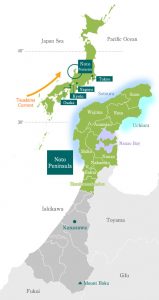 Conference to commemorate the 10th anniversary of Ishikawa’s ‘Globally Important Agricultural Heritage’
Conference to commemorate the 10th anniversary of Ishikawa’s ‘Globally Important Agricultural Heritage’
The Globally Important Agricultural Heritage Systems (GIAHS) is a project initiated by the Food and Agriculture Organization of the United Nations (headquartered in Rome, Italy) which aims to ensure food stability.
This year, Ishikawa Prefecture’s “Noto no Satoyama Satoumi (*)” region, which saw Japan as the first developed country designated with a Globally Important Agricultural Heritage Site in 2011, marked the 10th anniversary of its recognition. The 2021 International Conference on Global Agricultural Heritage will be held in Noto, the accredited area, in the autumn of this year with the cooperation of international organizations and the Japanese government.
Ishikawa Prefecture will use the 2011 anniversary of certification as an opportunity in the Noto region to unite in various regional promotion efforts, with the benefits spreading to various industries such as tourism and crafts. The conference aims to platform the efforts and achievements of this prefecture so far, as well as promote the value of the Globally Important Agricultural Heritage with policy to be disseminated domestically and internationally.
* Terminology and use of words
Noto: The topography of the Noto Peninsula is characterised by many low mountains and hills. Surrounded by the sea on three sides, the coastline is rich in variety, including shallow sandy beaches, the rocky shore called Sotoura, and the rias (long narrow inlets) along the coast called Uchiura. The climate is part of the Sea of Japan microclimate, with snow in winter and the Tsushima warm current flowing offshore, and Noto is relatively warm compared to other regions at the same latitude. There, a rich biota can be seen, such as the inhabitation of both warm and cold animals and plants. The Noto Peninsula is an inseparable region where ‘satoyama’ and ‘satoumi’ are closely connected in terms of land use, agriculture, forestry and fisheries, food culture, festivals, crafts, and biodiversity.
Satoyama: Satoyama is a term for an area formed by combining villages, agricultural lands, secondary forests, artificial forests, grasslands, bamboo forests, and ponds that surround them in a mosaic pattern, and when people use them appropriately, a rich natural environment is formed. It is an area that has been maintained. Satoyama is a place for people to live and their production activities, and at the same time, it is also a habitat for various species, and the local culture has various values such as nurturing the culture and landscape unique to the region.
Satoumi: A coastal area that is closely related to people’s lives, such as communities living in a natural landscape and enjoying the bounty of the sea, is called Satoumi. Satoumi has a highly productive and abundant ecosystem and is an important place for sea creatures such as spawning grounds for fish and habitat for their fry.
Conservation and utilization of Satoyama-Satoumi with a fund of 18 billion yen
In the Satoyama-Satoumi area, some achievements such as the creation of products and services that utilize local resources have been achieved, but the ageing of the population and the declining number of people continues and securing and training people has become an issue. To solve this problem, stakeholders are needed such as residents, companies, NPOs, and others to participate in creating solutions and support needed by the government. With the cooperation of local financial institutions, Ishikawa Prefecture established a fund of 5 billion yen in 2011 to financially support these various stakeholders’ efforts in areas of agricultural heritage. Using this investment and with donations from nations from local companies, the fund is supporting businesses that utilise local resources, promoting the Satoyama-Satoumi area, promoting conservation activities with the participation of local stakeholders, and the importance of the benefits of local agricultural heritage. Ishikawa Prefecture has been proactively promoting measures to build up abundant biodiversity and revitalise areas of agricultural heritage, as well as policy dissemination and educating the public.
Recently, in cooperation with financial institutions in the prefecture, the size of the fund has been increased to 18-billion-yen, support for the development of new products and services has been further enhanced, and the introduction of strong new leadership. Ishikawa Prefecture will continue to endeavour for the long term conservation and utilisation of Satoyama and Satoumi.
See the link below for further details:
http://www.pref.ishikawa.jp/satoyama/noto-giahs/f-lang/english/index.html

